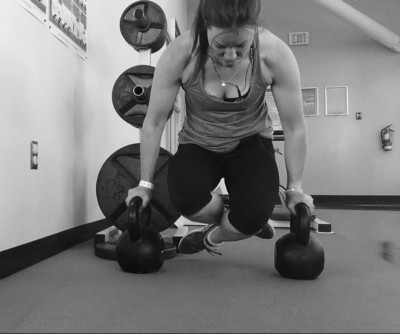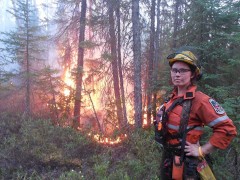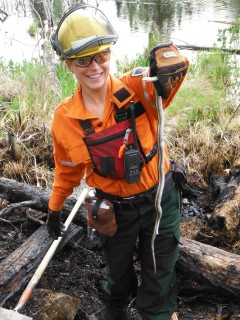 Ask anyone, anywhere, “what’s the deal with all the missing First Nations women,” and I guarantee that the only answers you’ll get in return are shrugged shoulders, or an “ I dunno really.” Despite plaguing Facebook and news pages for weeks, I continue to hear few answers explaining what is going on, what it all means, or what the current situation is. All that people can really tell me, is that First Nations women continue to go missing, and nothing is really being done to stop it.
Ask anyone, anywhere, “what’s the deal with all the missing First Nations women,” and I guarantee that the only answers you’ll get in return are shrugged shoulders, or an “ I dunno really.” Despite plaguing Facebook and news pages for weeks, I continue to hear few answers explaining what is going on, what it all means, or what the current situation is. All that people can really tell me, is that First Nations women continue to go missing, and nothing is really being done to stop it.
People have heard that Aboriginal women are four times more likely to be killed than non-Aboriginal women in Canada. That they make up over 25% of the Canadian female homicide victims. That’s huge. And as expected, there’s quite a bit of local outrage over the way the Aboriginal Affairs Minister responded, declaring that communities simply need to take greater responsibility for their missing and murdered women. He identified an overall lack of respect for women and girls on reserves, saying that needs to change. RCMP officers identify that 30% of Aboriginal female homicides involve acquaintances of the victim. Where “acquaintances” is defined as “closer friends, neighbors, authority figures, business relationships, criminal friendships, and people who don’t fit one of the previous stated categories”… aka- anyone and everyone who lives in a small First Nations community, as populations are as low as 600 people. And when you ask people from these communities about the overall health, they’ll say “oh yeah, well our health is really good these days. I mean, we’re still technically labeled in a state of emergency, but that’s just because of those two murder suicides we had last year.” It’s all something I cannot wrap my head around.
 I grew up with two sisters and a brother. A stay home mom who went back to work when the youngest was four. I didn’t know any hippies, or feminists. But everyone in our household was treated equally. Everyone held the same expectations. No excuses, no exceptions. Turns out, my parents raised three tough girls. So when APTN’s director of Playing with Fire asked me “How come there aren’t more women in the fire program?” I was genuinely stumped. I couldn’t think of a reason why more girls weren’t participating in the best paying, most enriching and exciting summer job I’d ever stumbled upon. I think I responded with something like “I guess the work can be pretty tough sometimes,” not sounding convinced that my response answered the question at all.
I grew up with two sisters and a brother. A stay home mom who went back to work when the youngest was four. I didn’t know any hippies, or feminists. But everyone in our household was treated equally. Everyone held the same expectations. No excuses, no exceptions. Turns out, my parents raised three tough girls. So when APTN’s director of Playing with Fire asked me “How come there aren’t more women in the fire program?” I was genuinely stumped. I couldn’t think of a reason why more girls weren’t participating in the best paying, most enriching and exciting summer job I’d ever stumbled upon. I think I responded with something like “I guess the work can be pretty tough sometimes,” not sounding convinced that my response answered the question at all.
 I actually thought about that question for days after the interview, still coming up blank every time. “How come there aren’t more women in the fire program?” As I looked around, every girl I saw was a strong girl: cutting trail all day with a chainsaw; an adventurous girl: finding treasures in the burn while doing mop up; an independent girl: leading her team of boys through the forest and to safety. It took me a while to realize that I am constantly surrounded by the same type of girl. Few and far between are the girls in my life who hate bugs. Who need their luxuries. Who don’t want to work hard. Who don’t see the point in needing to keep up or wanting to be one of the boys. I am so fortunate to be constantly surrounded by strong, empowered, and independent women.
I actually thought about that question for days after the interview, still coming up blank every time. “How come there aren’t more women in the fire program?” As I looked around, every girl I saw was a strong girl: cutting trail all day with a chainsaw; an adventurous girl: finding treasures in the burn while doing mop up; an independent girl: leading her team of boys through the forest and to safety. It took me a while to realize that I am constantly surrounded by the same type of girl. Few and far between are the girls in my life who hate bugs. Who need their luxuries. Who don’t want to work hard. Who don’t see the point in needing to keep up or wanting to be one of the boys. I am so fortunate to be constantly surrounded by strong, empowered, and independent women.
I was a female rookie crewmember, along side another female rookie crewmember. Sometimes I wonder how my crew leader and crew boss felt that year, knowing they would be training and fighting fire with two girls in their early twenties. I’ve worked alongside a few different girls in the program since, and can honestly say, I’ve yet to meet one who works as hard as we did in that first year, always striving to bust the image of two weak, useless female rookies. It was completely our own prerogative, and maybe a bit of unspoken competition between us, but regardless the reason, we both have stuck around the program, and have both assumed roles of respected deadly women on base.
 So when I hear about these headlines, of missing and murdered women, my brain does not compute. While some people feel anger, or disgust, confusion, indifference, embarrassment… I feel disbelief. I’m baffled. Speechless. Numb. I don’t understand why this is happening. Where are all the deadly women, who are standing up for what they believe? Who are being treated and know that they deserve the same respect as every man surrounding them? I don’t understand how the Minister of Aboriginal Affairs can wave a hand and conclude that it’s all part of the intergenerational violence and trauma portrait. How does that justify this continued behavior? If we can’t rid of excess violence and maltreatment of women, we should be focusing our attention on empowerment, no? I don’t understand how my federal government can say that an inquiry into the number of missing and murdered Indigenous women is something that they aren’t interested in. In a nation that claims to support and promote equality, does that statement not completely disregard the pretenses for equal treatment?
So when I hear about these headlines, of missing and murdered women, my brain does not compute. While some people feel anger, or disgust, confusion, indifference, embarrassment… I feel disbelief. I’m baffled. Speechless. Numb. I don’t understand why this is happening. Where are all the deadly women, who are standing up for what they believe? Who are being treated and know that they deserve the same respect as every man surrounding them? I don’t understand how the Minister of Aboriginal Affairs can wave a hand and conclude that it’s all part of the intergenerational violence and trauma portrait. How does that justify this continued behavior? If we can’t rid of excess violence and maltreatment of women, we should be focusing our attention on empowerment, no? I don’t understand how my federal government can say that an inquiry into the number of missing and murdered Indigenous women is something that they aren’t interested in. In a nation that claims to support and promote equality, does that statement not completely disregard the pretenses for equal treatment?
 At the end of the day, I understand that no amount of collected stats that quantify the frequency of missing or murdered women will control its occurrence. And I understand that intergenerational violence and trauma, and learned behavior are factors that will never be eliminated by a snap of someone’s fingers. But I would like to see more empowerment. More strong female role models, representing our gender as independent and unbreakable. Who aren’t afraid to speak their minds, stand up for their beliefs, and kick some ass.
At the end of the day, I understand that no amount of collected stats that quantify the frequency of missing or murdered women will control its occurrence. And I understand that intergenerational violence and trauma, and learned behavior are factors that will never be eliminated by a snap of someone’s fingers. But I would like to see more empowerment. More strong female role models, representing our gender as independent and unbreakable. Who aren’t afraid to speak their minds, stand up for their beliefs, and kick some ass.
 I’d like to call on all deadly women. It’s time to step up and represent. It’s time to demand respect and honour. Not because we need a movement, or a parade. Just because we need to remember that women are strong, capable, independent, and amazing. Because sometimes we forget this. Because we all need someone in our lives who inspires us to run a little faster, jump a little higher, and work a little harder. So that when I ask “what’s the deal with all the missing First Nations women,” I can’t wait to hear someone tell me “yeah, those were messed-up times.” And when I get asked, “how come there aren’t more women in the fire program?” I can’t wait respond with a furrowed brow, confused look, and say “what do you mean?”
I’d like to call on all deadly women. It’s time to step up and represent. It’s time to demand respect and honour. Not because we need a movement, or a parade. Just because we need to remember that women are strong, capable, independent, and amazing. Because sometimes we forget this. Because we all need someone in our lives who inspires us to run a little faster, jump a little higher, and work a little harder. So that when I ask “what’s the deal with all the missing First Nations women,” I can’t wait to hear someone tell me “yeah, those were messed-up times.” And when I get asked, “how come there aren’t more women in the fire program?” I can’t wait respond with a furrowed brow, confused look, and say “what do you mean?”
Author Ariel Root is currently in Kenora in her fourth season working as a forest fire fighter for the Ontario Ministry of Natural Resources and Forestry. She has a BSc in Food Science & Nutrition from Carleton University in 2012, and is currently a graduate student in the Health Science, Technology and Policy program at Carleton University. She has been featured on APTN’s new hit TV show, Playing with Fire, Season 2.
Come back for next week’s instalment.
Photos by Ariel Root
Follow us on twitter!